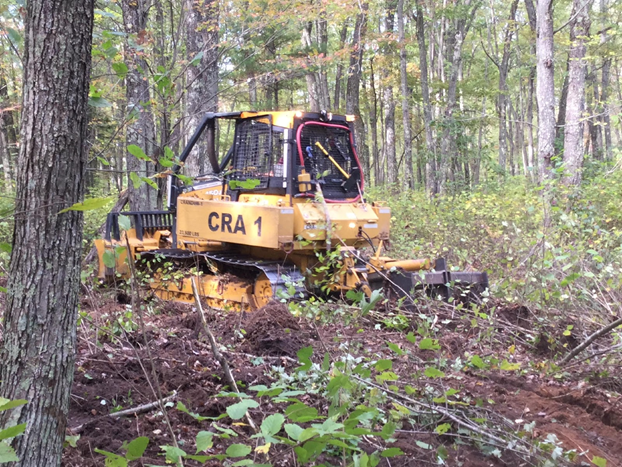Overview
The prescriptions for the nine stands involved in this trial were developed and implemented through the Good Neighbor Authority partnership between the U.S. Forest Service and Wisconsin Department of Natural Resources. All stands were primarily red oak dominated with various mixtures of white pine, red pine, red maple, and aspen. The shelterwood regeneration method was prescribed for all stands to begin the regeneration process and promote conditions favorable for the establishment of red oak, white pine, and red pine. The trial included three different pre-sale mechanical scarification techniques, utilizing a root rake, Headson scarifier, and Salmon blade. This report is an initial summary of the scarification treatments. Additional information will be provided on treatment results as future regeneration surveys are conducted.
Silviculture Objective(s)
Short Term: Regenerate this stand to an oak/pine type using a shelterwood regeneration method. Regeneration efforts for pine and oak will employ a 2 to 3 cut uniform shelterwood, starting with presale scarification of the sale area to create a suitable seedbed, followed with a seeding cut during this entry.
Long Term: Promote a component of long-lived conifer stands within Management Area 4B (45-70% red pine/white pine) with an oak component, for quality sawtimber and wildlife habitat associated with the Northern Dry-Mesic Forest natural community. Enhance structural diversity during future harvests by releasing additional/new pine and oak cohorts. Recruit potential snags, den trees, and coarse woody debris.
Pre-treatment stand description and condition
Pre-treatment species composition:
Overstory - The stands are mostly red oak dominated with various mixtures of pine, red maple, and aspen. Most common species include: Quercus rubra, Acer rubrum, Pinus resinosa, Pinus strobus, Abies balsamea, Populus grandidentata, Populus tremuloides, Betula papyrifera.

Figure 1: Stand 4070-003 diameter distribution
Understory – Most stands contain an abundant layer of hazel (Corylus spp.), along with small advance regeneration of red maple, red oak, and white pine.

Figure 2: Stand 4070-003 understory regeneration
Pre-treatment growth and stocking:
Table 1: Overstory basal area:
| Stand | Basal area (ft2/acre) |
| 4069-010 | 130 |
| 4069-017 | 1231 |
| 4069-018 | 115 |
| 4069-020 | 150 |
| 4070-003 | 105 |
| 4070-008 | 127 |
| 4072-007 | 100 |
| 4072-027 | 109 |
| 4072-052 | 99 |
Pre-treatment forest health issues:
The understory interfering vegetation is too dense (i.e., hazel) and does not allow for oak regeneration/recruitment.
Landowner objectives/situation:
Utilize mechanical scarification to control interfering vegetation and create a suitable seedbed for oak and pine regeneration.
Silviculture Prescription
Since northern red oak, eastern white pine, and red pine are the desired dominant tree species across all nine stands, the focus of this trial was to test different mechanical scarification techniques to control interfering vegetation (e.g., hazel) and to create a favorable mineral soil seedbed for germination of these species. Mechanical scarification using small dozers with various attachments has become increasingly common in Wisconsin, especially to promote oak regeneration by uprooting vegetation, exposing mineral soil, and incorporating acorns. This trial compared three different scarification attachments (i.e., root rake, Headson scarifier, and Salmon blade) to evaluate operating costs and effectiveness. All scarification was conducted pre-harvest in early fall prior to or just after seed fall. The prescription called for shallow scarification of at least 50% of the ground area.
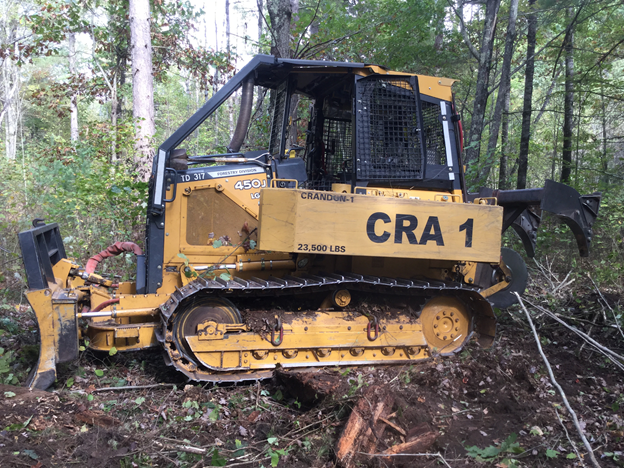
Figure 3: Headson scarifier. Developed at the WDNR Forestry Equipment Research and Development Center in Tomahawk, WI.
Following scarification treatments, all stands will be harvested using a 2 or 3-cut shelterwood, with an initial seeding cut to a 50% crown cover to improve light conditions for developing seedlings. Designated seed trees will favor red oak, followed by white pine and red pine. Once adequate regeneration is established, the overstory will be mostly removed in stages. Long-term objectives include managing on an extended rotation and promoting uneven-aged cohorts within the stands, so reserve trees and reserve patches will be maintained in subsequent harvests.
What actually happened during the treatment

Figure 3: scarification treatment locations and acreage
Pre-harvest scarification was conducted in late September to early October of 2017, treating a total of 145 acres. Figure 3 shows the location and acreage of each treatment method. Scarification was limited to a portion of most stands, due to the presence of adequate advance regeneration in some areas that were protected and left unscarified. Wisconsin DNR fire dozers and operators were used to work the three scarification attachments.
Post-treatment assessment
Initial assessments determined that all three scarification methods successfully exposed mineral soil and uprooted or damaged interfering vegetation, but with varying degrees of disturbance and operational efficiency. The Headson scarifier had the best production rate of 2.5 acres/hour, or nearly twice as fast as the other methods. The Headson was also very maneuverable and being a rear attachment meant that the dozer blade could be used in tandem to move debris and shear/root-spring vegetation in front of the dozer. One pass did not yield the best results however, so multiple passes were needed to remove much of the hazel (see Photo 2).
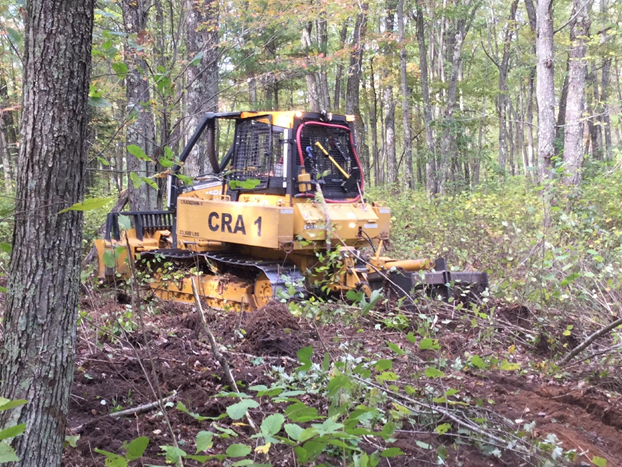
Figure 4: Headson scarifier in operation.
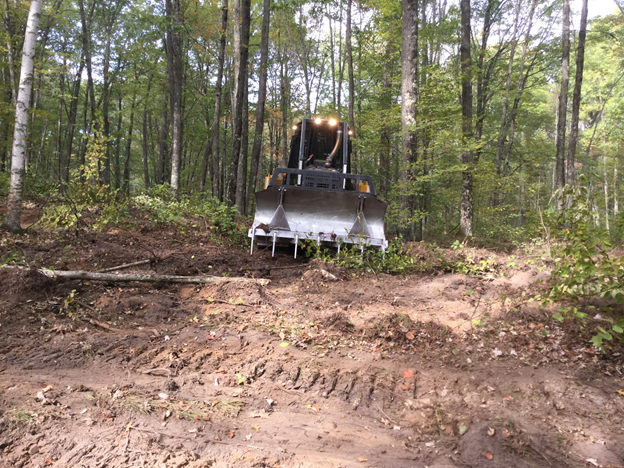
Figure 5: Root rake attachment.
The Salmon blade was the second fastest production rate at 1.7 acres/hour. Operators had difficulty with this attachment due to the lack of visibility of the forks/blades, which were somewhat hidden behind the main dozer blade (see Photo 5). Maneuverability was also difficult due to the plow attachment on the back of the dozer. Operators felt the Salmon blade was less prone to getting clogged with debris and did a good job of exposing mineral soil.
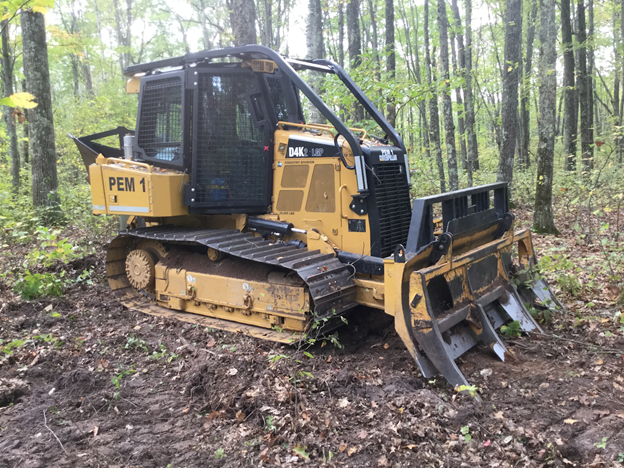
Figure 6: Salmon blade attachment.
The root rake had a somewhat slower production rate at 1.2 acres/hour. Operators felt the root rake was maneuverable, visible and effective at uprooting the hazel, but was more easily clogged with debris due to the multiple teeth and generally exposed less mineral soil (see Photo 4).
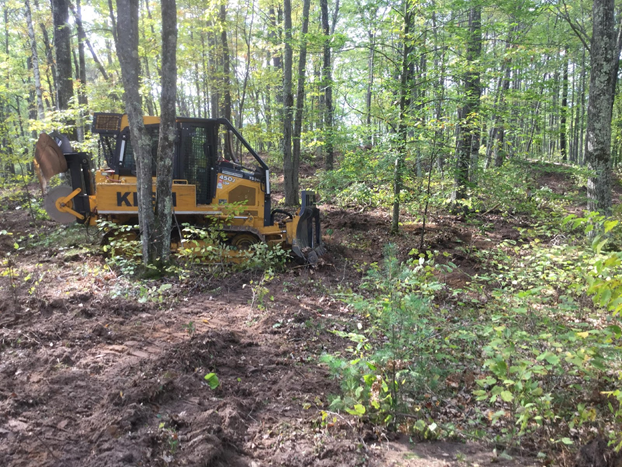
Figure 7: Root rake in operation
Post-treatment regeneration data are not yet available. Regeneration surveys will be conducted at years three and five post-treatment. USFS natural regeneration standards for the Chequamegon-Nicolet will require a minimum of 550 red oak or 800 white pine stems per acre by year five in these stands.

Figure 8: Salmon blade in operation.
Plans for future treatments
The shelterwood seed cuts have been established within the nine stands and will be harvested in the years 2018 and 2019. Regeneration surveys will be conducted in the years 2021 and 2023. Photo points taken prior to treatments will also be used to evaluate treatment impacts to the interfering vegetation.
Costs and economic considerations
Figure 3 shows the production rates for each scarification treatment in this trial. The Headson scarifier had the fastest production rate especially in more open stands, however this attachment may require multiple passes to achieve the desired results. Overall productions rates were variable by operator and experience level. Operators felt that production rates could be improved as they become more experienced on each scarification attachment.
Summary / lessons learned / additional thoughts
Comments from the equipment operators included suggestions to remove some of the standard fire dozer equipment prior to scarification operations. With the root rake and Salmon blade, removal of the fire plow would improve overall maneuverability within the stand. Removal of fire curtain would improve visibility for the operator.
